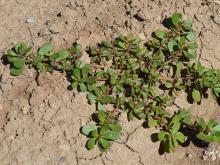Wildflowers, Grasses and Other Nonwoody Plants
Media

Species Types
Scientific Name
Cirsium vulgare
Description
Bull thistle is a weedy introduction from Europe, found statewide. To tell it from our other thistles, note its stems with spiny-margined wings, and its leaves with the upper surface strongly roughened with stiff, spiny bristles.
Media

Species Types
Scientific Name
Cirsium altissimum
Description
Tall thistle is a native thistle that can grow to be 10 feet tall! To identify it, notice its leaves, which are unlobed (though they may be wavy or have only shallow, broad lobes), are felty-hairy beneath, and have prickles only along the edges.
Media

Species Types
Scientific Name
Tradescantia ohiensis
Description
Smooth spiderwort is the most common and widely distributed of Missouri's spiderworts. It has slender, straight or zigzag stems. The long, narrow leaves are folded lengthwise and attach to the stem in a thick node. The 3 petals of the triangular flower are blue, rose, purple, lavender, or white.
Media

Species Types
Scientific Name
Capsella bursa-pastoris
Description
Shepherd’s purse is a plant that started in Europe and western Asia and has been introduced nearly worldwide. Like the common dandelion, it has several adaptations that make it a successful colonizer of disturbed soil.
Media

Species Types
Scientific Name
Comandra umbellata (formerly C. richardsiana)
Description
Bastard, or false toadflax is one of the hundreds of wildflowers that bejewel our native prairies. A perennial herb with yellowish-green foliage and smooth, upright stems, it grows and flowers under the hottest conditions.
Media

Species Types
Scientific Name
Portulaca oleracea
Description
Purslane can be an aggressive pest in gardens and is one of the worst agricultural weeds in the world. Meanwhile, it’s also a favorite wild vegetable served cooked or raw, and many people cultivate it.
Media

Species Types
Scientific Name
Barbarea vulgaris
Description
Yellow rocket is a mustard native to Eurasia that was introduced long ago and today is found across North America. The mustard family used to be called the Cruciferae, because of the cross shape formed by the four petals.
See Also
About Wildflowers, Grasses and Other Nonwoody Plants in Missouri
A very simple way of thinking about the green world is to divide the vascular plants into two groups: woody and nonwoody (or herbaceous). But this is an artificial division; many plant families include some species that are woody and some that are not. The diversity of nonwoody vascular plants is staggering! Think of all the ferns, grasses, sedges, lilies, peas, sunflowers, nightshades, milkweeds, mustards, mints, and mallows — weeds and wildflowers — and many more!





















